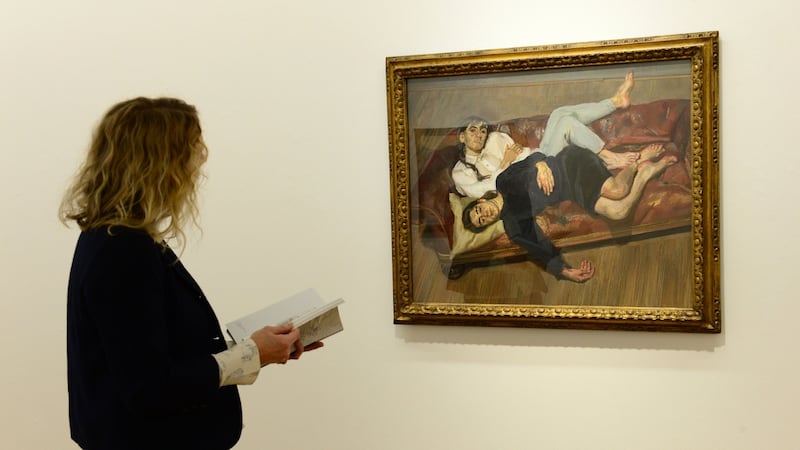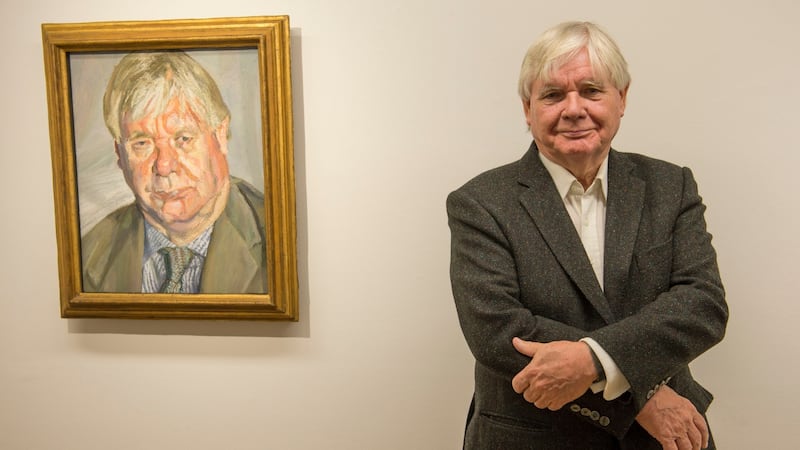Thanks to the Freud Project, the Irish Museum of Modern Art (Imma) is the place to go to if you want to see a first-rate, representative collection of the work of Lucian Freud over the next five years.
A show of his self-portraits is planned for 2019, and the next major survey show is pencilled in for the centenary of his birth in 2022. In the interim, about 30 paintings, many of them key pieces, all of them worth seeing, and 20 works on paper will be on long-term loan to Imma’s collection.
They will be on view in the building formerly known as the Garden Galleries, which is now the home of the Freud Project. They are drawn from a number of private collections, including that of one of Freud’s sitters.


Freud's close friend, fellow painter Frank Auerbach, once remarked that nobody ever produced a work of art in the life-drawing room. In Auerbach's work, his relationship with his sitters was always primary.
Freud too upped the ante by painting people who were close to him in various ways – lovers, friends, children – with, as Catherine Lampert, who curated Imma's 2007 exhibition of his work, put it, "delicacy and disturbing corporeality". Where she sees delicacy, incidentally, others see brutality or cruelty.
Freud tends to short-circuit our conditioned responses. When he paints what he called a “naked portrait”, he manages to convey the feeling of being in the presence of not so much a nude in the culturally sanctioned sense of the term, as a naked, animal presence, which is inevitably disturbing.
It is sexual but a lot more besides. That more – the intimation of another autonomous, unknowable, animal being – is what tends to be lost in formulaic representations of the human figure.
Imma features several studies of his mother Lucie Brasch late in her life. She became a recurrent subject – for 13 works – after she became depressed following the death of her husband. There are also two superb self-portraits, from 1949 and 1985.
In fact, there are too many highlights to itemise. And one of the delights of the exhibition is the number and quality of the 19 etchings, dating from his return to the medium after a 30-year absence in the early 1980s. Working obsessively on a large scale, he produced works easily on a par with his paintings.
Demanding regimes
Freud was born in
Berlin
in December 1922. He was named after his mother Lucie. His father was
Ernst Freud
, an architect and the fourth child of the psychoanalyst
Sigmund Freud
. Lucian had an elder brother,
Stephen Gabriel
, and a younger one, Clement.
As conditions for Jews deteriorated with the rise of the Nazis, the family moved to London in 1933. Freud had a certain amount in common with Auerbach. Now in his mid-80s, Auerbach also ended up in London because of the Nazis and thrived there. In time, Freud rated him as the best British painter of his generation.
They became good friends from the mid-1950s on. A crucial difference was that Auerbach’s parents sent him out of the country at the last minute, in 1939, and he never saw them again. They were both killed in a concentration camp in 1942.
To put it mildly, neither artist liked to dwell on the past, and both became known for the demanding regimes they imposed on their sitters. It has been suggested that their childhood experiences contributed to their desire to keep their subjects in place, to stop them disappearing.
By his own acknowledgement, Freud was extremely controlling: he liked to communicate by phone, but gave no one his number. He compartmentalised his life to a dramatic degree.
Temperamentally, he and Auerbach were quite different. Auerbach is famously a creature of austere habit who mixes with relatively few people, whereas Freud was fundamentally sociable and socially adept. He knew everyone and was instantly at home in any company.
He gambled quite recklessly, incurring debt and associated risks (The Big Man, at Imma, is a bookmaker he befriended, and painted). He led a famously complex and secretive personal life, pursuing a sequence of overlapping relationships and fathering about 15 children, probably more.
His marriages did not last that long. He was four years with Kathleen Epstein and, soon after, four with Lady Caroline Blackwood. By all accounts, breaking up with Blackwood, in 1957, affected him more profoundly than the end of any other sunder.
He did, though, have several other long, significant relationships, including one with Suzy Boyt. They had four children together. He and Katherine Margaret McAdam (who, finally exasperated, cut off all contact with him), also had four children.
Bernardine Coverley is the mother of Bella and Esther (together in a superb painting at Imma). Jacquette Eliot and Celia Paul each had a child with him. Over many years, the baroness Willoughby de Eresby and Susanna Chancellor were close and important to him.
Concentrated looking
In Freud’s case, the answer to the popular question – “What is it a painting of?” – is usually pretty obvious. Nothing is abstracted or concealed. Surely it is a painting of a head or of a figure in a room, one could say.
Yet that is probably the wrong way to think about his work. Each painting emerges from a process of concentrated looking and mark-making, but the more you examine his work, the more it seems that he is not trying to make a representation in the conventional sense, a convincing two-dimensional rendering of a three-dimensional subject.
He appears supremely indifferent about whether things look right in that sense. He never seems to say to himself: “Well, this should look a certain way, should imitate a scene.” He is simply not aiming for that illusionistic effect.
He worked across the surface of a painting piecemeal, concentrating on one tiny area at a time, sometimes starting with the head, for example, if he was painting a figure.
When a section of a painting felt right to him, he left it alone, perhaps revisiting it later on, perhaps not. He reportedly liked to leave a section of canvas blank until quite late in the proceedings.
When he looked at a completed picture, it never seemed to bother him for a second that the proportions had gone awry or that the composition was more than a bit awkward.
You can see this time and again in the works at Imma. Auerbach, quoted by Lampert, hit the nail on the head when he said: “I think of Lucian’s attention to his subject. If his concentrated interest were to falter, he would come off the tightrope. He has no safety net of manner.”
Honest witness
On occasion, Freud felt free to add on bits of canvas to accommodate something he couldn’t fit in initially (
Portrait of Christopher Bramham
, painter and friend) or he would allow a painting to develop organically, as people came and went and circumstances changed – or a child was born, as happened with
Rose Boyt
in
The Pearce Family
. The baby is accommodated in the finished work.
As regards appearance, he seemed to feel that if he was true to his process, if he was an honest witness, then appearance could really look after itself. He had done his job.
That is, he wasn’t aiming to capture in a painting some image beyond or outside of the painting, he wasn’t working towards some ideal notion. “As far as I’m concerned,” as he said, “the paint is the person.”
Like it or not, the painting is it. We, as viewers, can feel liberated to make of the work what we will.
Imma Collection: Freud Project: 50 works by Lucian Freud, 30 paintings and 20 works on paper, on five-year loan (Garden Galleries until October 2017 and thereafter until 2021. Admission: €8/€5). Irish Museum of Modern Art, Royal Hospital, Kilmainham. imma.ie












